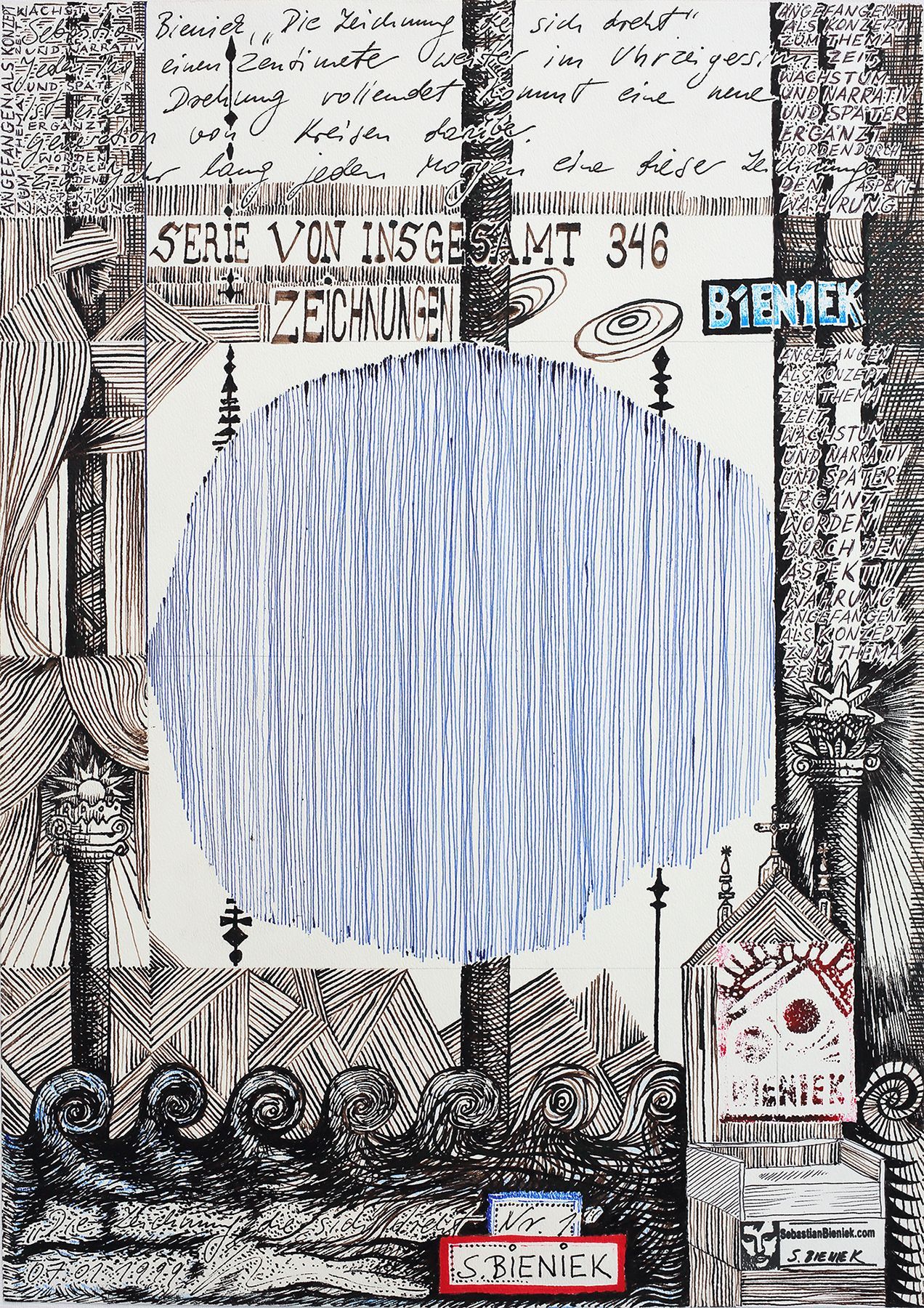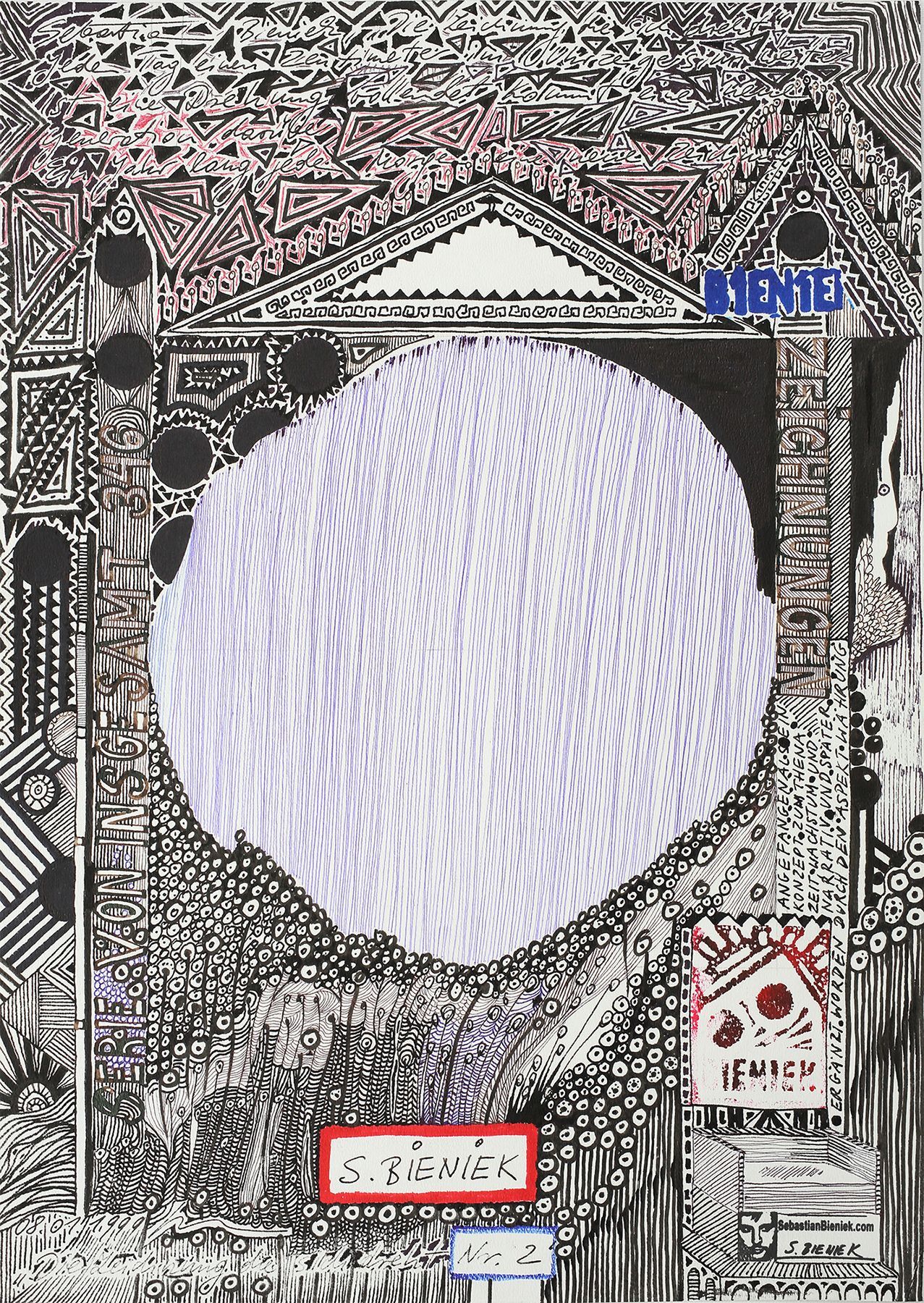"The Turning around drawing", conceptual artwork
by Sebastian Bieniek (B1EN1EK), 1999
Series of 346 drawings!
What is the difference between "Performance", "Action Art", "Installation Art" and
Video Art?
When the artist or the body of the artist is in focus, so the acting is part of the artwork, it's a performance. When the artist isn't visible but it's still about people and when it's that fast changing in time that you can see the "Beginning" and then "End", than it's "Action Art" (Happaning is kind of outsourced - not directed by a single artist but by many). Installation is when you can't see it "changing" in time, so it looks always the same, or can be at least restored, and when it's about objects.
However even still some installations like "My Breath rests here" ("Hier ruht mein Atem") have some performance character (at least in the creation phase), but than again not really, because than "the painting of a painting" could be also a performance, so it's more about the focus. Or take the (big) "Please Ignore This" from 2018 and compare it to other Bieniektext textart. What's the difference? It's only the size.
A recorded and shown as a video performance, without real life viewer and the interaction with the viewer like "The 30 € truth" or "Crying for this Video" for example is a video.

Work in progress: „The Turning around drawing“ ("Die Zeichnung die sich dreht")
series by Sebastian Bieniek, 1999.
What is the differance between
Installation Art , "other conceptual art" and
sculpture?
Installation is somehow big. If you can't carry it away it's an Installation.
If it's small enough that you can carry it away and when it's technically not unique (so you can't recognize a signature by the making, or - even - somobody else did it, like the "overpainted Sebastian Bieniek") but - may be - by the "spin" of the idea, than it's Bieniek's "other conceptual art".
And than: sculpture is when it's made by the artist himself and one needs a little "artist like" skills to do it, or at least everbody would do it kind of different, but this "different" was made by the artist himself.
Nevertheless some artwork like "Recycled Sol LeWitt" , or the "The Stolen 100 DM" are still hard to collate. What is it? At the beginning it's "Action Art", than depending on the presentation, it could be an Installation (if you take a lot and make it big), and if you just take (one) the final result could also be a sculpture, but according to the definition "without special skills and skill-signature it's other conceptual art, it's "other conceptual art.
(Bieniek's definition)
Wooden box with 346 drawings from the „The Turning around drawing“ ("Die Zeichnung die sich dreht")
series by Sebastian Bieniek, 1999.
Sebastian Bieniek has drawn with a pen in 1999 for around one year every morning for one hour one of the drawing from „The Turning around drawing“ series.
The drawings look like a „thin lines circle“ that is turning every day a little around - like the hands of a clock.
All together the series consists of 346 DIN A3 drawings. Each DIN A3, ballpoint pen on heavy paper, signed, numbered, stamped.
"The Turning around drawing" ("Die Zeichnung die sich dreht"),
conceptual artwork by Sebastian Bieniek, 1999
The concept is similar to the color raw, the wood raw sculpture, the "Here rests my Breath" (Hier ruht mein Atem) installation and the "No turning around turning around head" video concept from the same year 1999.
A process that at some point becomes independent and writes its own "story". This is based on the idea that there is only "the" one story that is in everything and that is simply told in different forms.
Here, in particular, a circle is built with very finely drawn lines.
The lines of the first drawing, and thus circle no. 1, have a vertical orientation.
The lines in the second drawing, on the other hand, shift one centimeter to the left along an alignment set along the upper edge of the sheet, thus starting a clockwise movement.
After about 140 drawings, the circle has turned once.
After the circle has rotated once, the center of the circle shifts (begins to rotate in turn) and a second rotation - according to the same principle - begins.
In doing so, however, the circle that stands for the previous rotation - forms its shadow, so to speak - is shown as a circle. So you can see what the circle refers to. Was he left behind and where he's moving.
A visible and thus formal narrative axis emerges that has a past and a future, a before and after.
This is also about the narrative as an organism, its growth and the time itself which seems to be the atom of all narratives and also all growing.
Later this concept was completed by the concept and idea of a "currency" which aims to be the atom of the value.
Sebastian Bieniek, 1999-2024, „The Turning around drawing no. 1“ ("Die Zeichnung die sich dreht Nr. 1").
Sebastian Bieniek , 1999-2024, „The Turning around drawing no. 2“ ("Die Zeichnung die sich dreht Nr. 2").
Sebastian Bieniek , 1999-2024, „The Turning around drawing no. 3“ ("Die Zeichnung die sich dreht Nr. 3").
Sebastian Bieniek , 1999-2024, „The Turning around drawing no. 4“ ("Die Zeichnung die sich dreht Nr. 4").
Sebastian Bieniek , 1999-2024, „The Turning around drawing no. 5“ ("Die Zeichnung die sich dreht Nr. 5").
I. Links social media:
- DZDSD - "Die Zeichnung Die Sich Dreht" Podcast on Youtube
- DZDSD - "Die Zeichnung Die Sich Dreht" Facebook page
- DZDSD - "Die Zeichnung Die Sich Dreht" on Twitter
- DZDSD - "Die Zeichnung Die Sich Dreht" on Pinterest
- DZDSD - "Die Zeichnung Die Sich Dreht" Linktr.ee
- DZDSD - "Die Zeichnung Die Sich Dreht" Podcast on spotify
- "Die Zeichnung die sich dreht" on pinterest (Sebastian Bieniek account)
- Video of Sebastian Bieniek drawing the "Die Zeichnung die sich dreht" in 1999 (S. Bieniek account)
- ...
II. Links Press:








